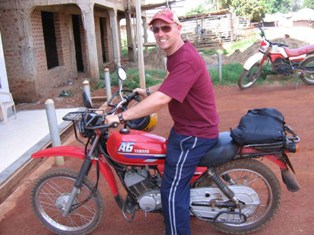1. Why was Uganda a good place for you to start your research, considering armed forces recruit youth in other regions such as Sri Lanka and Sierra Leone?
I was given the opportunity for post-doctoral studies with a UNICEF partnership Sport for Development Peace program in Southern Sudan. However, with security threats and continued instability, I was relocated to Uganda. I felt very comfortable accepting this opportunity because of my familiarity with the region and knowledge of the conflict. Worldwide, hundreds of thousands of children and youth are forcibly recruited into fighting forces. While conflicts in other regions utilized children in these forces, some with abductions and conscription, the Lord’s Resistance Army (LRA) solely abducted children and youth throughout Northern Uganda and forced them into various roles and subjected them to horrific acts of violence. In addition, the conflict instigated the ‘night commuter’ phenomenon where tens of thousands of children trekked many kilometers from their homes to town centers at night to escape abduction. These unique instances brought challenges to psychosocial programming for vulnerable children and youth in the region.
2. What are the main long-term objectives of your research?
The most important aspect of this research is to produce contextually relevant, practical implications that can assist local governments, community-based organizations, national and international NGO’s, and other key community stakeholders with sport-based psychosocial programming. The key is to build on the technical capacity of the local individuals within the region to implement and sustain such programs.
One example of this would be the research findings that emphasized the need for greater social inclusion of children and youth with disabilities in sport. Many children and youth are victims of violence perpetrated by members of the LRA. Some of them returned with lost fingers, arms, legs, or a combination. We located landmine survivors who also lost limbs. Some are former abductees while others non-abducted victims of war. We found that these children were often excluded from sport because of a lack of knowledge on the part of participants, coaches, and sport teachers on how to go about including them in sport. With these findings, I am now coordinating trainings for these individuals to learn modifications to sport activities that foster the inclusions of those with disabilities.
Through initial and follow up trainings we can foster the inclusion process, increase the technical capacity of key community members, build a greater level of social acceptance of these young victims of war, and ideally, cultivate peace and stability in the region.
3. The UN sees sport as not only an end, but a means or a tool to improve the lives of children. How have you seen this happen in Uganda?
In 2005, the United Nations declared 2005 the year of sport and physical education for all children. Just prior to this, they released a document entitled Sport for Development and Peace: Towards Achieving the Millennium Development Goals which outlined the means for realizing the potential of sport as a tool to improve the physical, social, and emotional development of children and youth as well as reaching important peace objectives.
In Northern Uganda, communities and organizations have used sport to mobilize large numbers of children and youth to convey important health messages (eg. HIV/AIDS awareness, malaria prevention), sustain peace and stability, and to support the inclusion of socially marginalized children and youth. For displaced children and former child soldiers, sport provides a sense of normality providing both structure in a destabilizing environment and means to channel energies in a positive direction. Former child soldiers find sport to be a means to reconnect them to the lives they experienced prior to their abduction, re-establishing a positive identity, and engaging them in socially- acceptable patterns of behavior.
4. Who are the main stakeholders of your research, and what are their roles?
As I mentioned earlier, a main goal of this long-term research project is to develop findings and practical implications that can be translated into program strategies that increase the technical capacity of those implementing sport for development and peace programs in the region. It is also my hope to garner the attention of local government officials to see the convening power of sport and support well-planned initiatives throughout the region, and country for that matter. On a larger scale, the practical implications can be shared globally so they can be transferred to other contexts where children and youth are victims of war. Finally, the research will add to the current body of knowledge on the reintegration of former child combatants and the continually emerging field of sport for development and peace.
5. What can entrepreneurial youth in the broader East African region do to mobilize for sport-for-development programming?
First and foremost, individuals must be well-informed of the context in which they plan to implement such programming. I spent a total of sixteen months conducting observational research in the region during the conflict in order to gain a better understanding of the uses of sport for children and youth in this region, issues surrounding children in armed conflict, and the reintegration process of former child soldiers. Then, a key issue related to development and/or peace may come to light through contact with members of the community including the children and youth. In my case, it was utilizing sport as means to reintegrate former child soldiers.
For instance, someone may find that youth have few opportunities for employment and lack the values and skills necessary to gain employment. Therefore, you might identify critical work-place values such as teamwork, tolerance, and effort, and how they can be emphasized through a sport program. Local business owners can serve as partners in the program by accepting participants for short-term internships thus transferring these underpinning values to the workplace. This is merely one example. There are many issues affecting the development of children and youth that can be addressed through sport.
There are many community-based organizations who established themselves in the villages, municipalities, or cities in which they operate and who wish to implement sport for development programming. It is often worthy to seek out such organizations and partner with them to build upon their capacity as well as the children and youth for whom they currently reach. Programs should include a rigorous monitoring and evaluation system to recognize whether you are meeting your program objectives. You may then begin to “scale up” your program once it is established you are meeting these objectives. Start small. The key is to focus on long-term sustainable programming that provides maximum impact for the children and youth you wish to involve.

I have known Dr. Ravizza for 13 years. He used to instruct my PE lesson in 4th and 5th grade (1997) at the International School of Tanganyika, and I lost touch with him the year after that. We got back in touch over Facebook in 2008, and I have been trying to keep up with him ever since. Thanks for doing this for us, Dean!
Watch this space for more updates on Dr. Ravizza’s work in Uganda. Contact him on dean (dot) ravizza (at) gmail (dot) com
Related links:


Additional link: Dr. Ravizza’s interview with Heifer International.
We need someone like this in Tanzania. I’m sure there are things that could be learned about community sustenance through football.
Nice interview!
I wonder how many Tanzanian youths get inspired after hearing such stories, and get up, get out there and do something?
Great interview. Very much enjoyed reading it. Dr. Ravizza is awesome for doing this 🙂
Three years since this interview, check out the program and how you can help! It is titled “Creating Inclusive Communities through Peaceful Play”.
http://www.indiegogo.com/projects/creating-inclusive-communities-through-peaceful-play